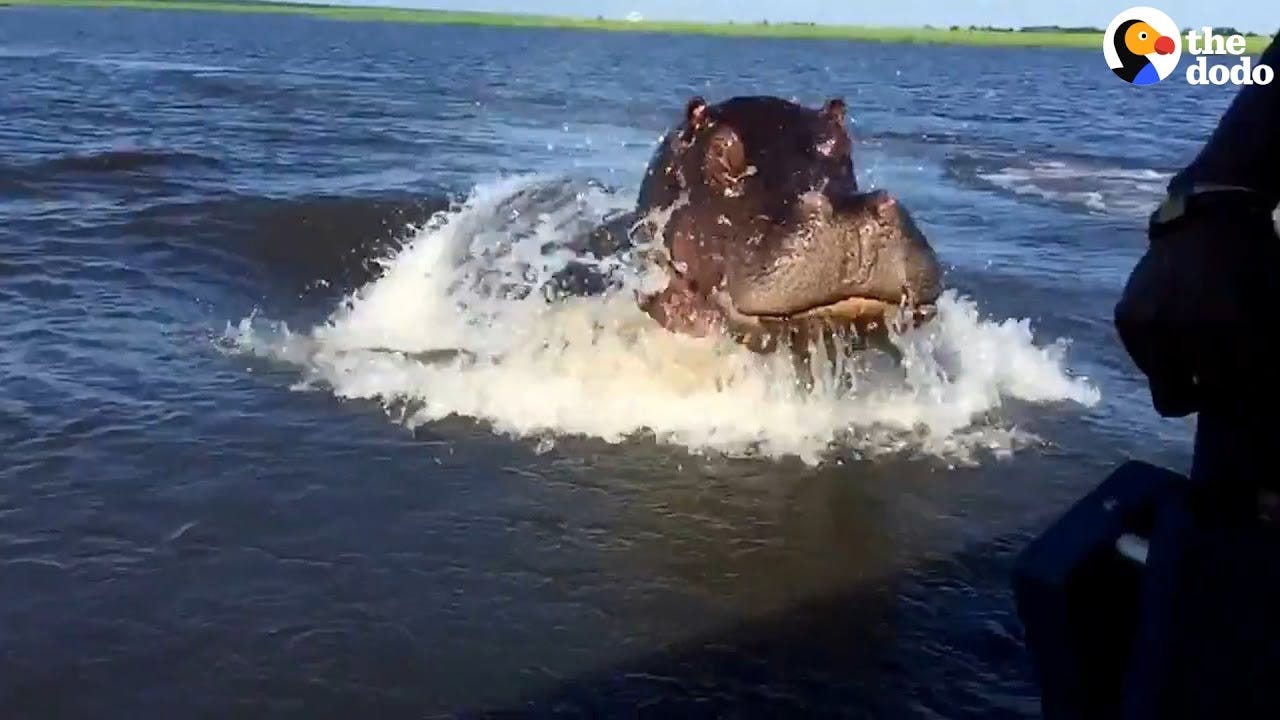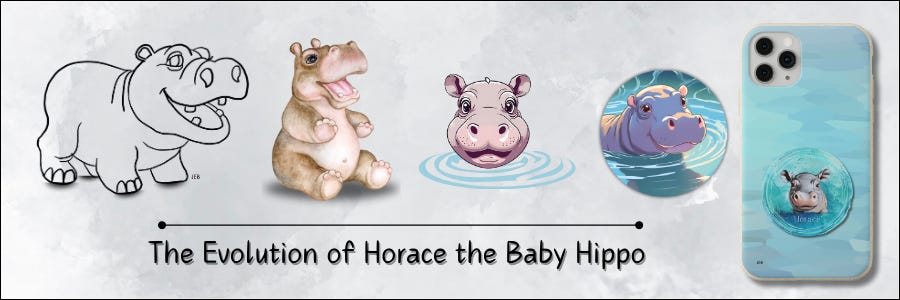Meet Horace the baby hippo. Horace is a special addition to the growing collection of critters I’ve been illustrating for my Buttons and Bows boutique.
Horace was inspired by a baby pygmy hippo named Moo Deng (the name means bouncing pig) who lives at a zoo in Thailand. Moo Deng became an internet sensation when one of her caretakers posted clips of her antics to the zoo’s social media account. Visits to the zoo more than doubled overnight.
Moo Deng is indeed cute, as is her larger relative Hyacinth Hippo - star of one of my favorite Disney films, Fantasia. But all that rotund charm masks some alarming facts. Hippos are territorial, ferociously aggressive, and can run underwater (they don’t swim) at speeds of up to 8 miles per hour. Eight miles an hour didn’t mean much to me until I saw the video below of a hippo chasing and almost catching a boat. Yikes!
Then there was the disturbing news out of Columbia where four hippos (originally imported by Colombian drug lord Pablo Escobar) have multiplied to 215 and are now posing a threat to the country’s ecosystems. So much for pink tutus, ballet slippers, and flirtatious dancing to Ponchielli's Dance of the Hours.
But the thing that makes Horace special for me is what he’s taught me about creativity and the health of my brain. It turns out that creativity is driven by memory. It requires the use of existing knowledge to come up with new or divergent ways of seeing or doing things. It will come as no surprise that many parts and abilities of the brain are involved in the creative process. These include:
The Prefrontal Cortex, which handles decision making and problem solving.
The Occipital and Parietal Lobes which are responsible for spatial orientation and visual processing. This is where imagination - the ability to simulate mental pictures, sensations, and ideas without sensory input - takes place.
The Limbic System, which is a collection of structures that help control emotions and motivation. The two that are especially important for creativity are the Amygdala and the Hippocampus (the inspiration for Horace). The Amygdala processes emotions and the Hippocampus converts short-term memories into long-term memories by organizing, storing, and retrieving them.
Neuroplasticity, which refers to the brain’s ability to think laterally - meaning consider a variety of scenarios, outcomes, and solutions other than what is expected - and then rewire itself to accommodate those outcomes. Psychologists call this “divergent thinking,” and it is a cornerstone of creativity.
If your eyes are glazing over from reading all the anatomical jargon above, I apologize. It was just too interesting not to share and may help when you embark on new creative projects of your own. Let’s get back to Horace.
After reading about and seeing videos of Moo Deng, I thought it would be fun to create my own version of a baby hippo. The process went like this:
Rough sketch on paper. My artistic training began before computers were even invented, so paper, pencil, pens, and paint are an integral part of how I “imagine” and translate my imaginings into something others can see.
Scan the sketch into my computer and use digital drawing tools - Photoshop, Illustrator, Procreate, and Fresco - to play around with color, texture, body language, and facial expression. For years I resisted learning and using these tools. They felt like cheating, and to be honest, were a PITA to learn (Photoshop was and IS a beast). It was only when pressure-sensitive tablets became available that I really began to embrace what these programs could do.
Look up royalty free illustrations of baby hippos on sites like Canva, iStock, FreePik, unDraw, and RawPixel, then play with addinng elements like the rings of water you seen in the third image above.
Play with AI. I confess to having mixed feelings about AI. The part of me that gets immense satisfaction from building an image from scratch - from rough sketches and layout to mixing and applying every dab of color - was/is slightly offended by programs that magically produce what could take me days, weeks, and even months to produce.
Then I realized real skill was needed to get acceptable results from AI, and that the two approaches to the creation of art are actually very different disciplines. I also discovered that I can generate a drawing of my own, upload it as a reference image, and let AI offer variations or even improve on it.
In other words, I did a little bit of divergent thinking, required my brain to accommodate a new if slightly annoying tool (I HATE it when AI adds or subtracts fingers or gives cats three tails). And voila, Horace was born.
Yes, Horace is a collaboration between myself and AI with some help from Canva - which has some gorgeous background images - and the elves at the print-on-demand (POD) company I am using. POD allows me to put Horace’s image onto phone cases, t-shirts, journals, and even ornaments!
Some Final Thoughts on Creativity and Brain Health
(Condensed from “How Creativity Actually Improves Your Health,” by Ashley Stahl)
Creativity Generates Happiness
Repetitive creative tasks like knitting, drawing, or writing help activate flow (that wonderful state in which times falls away and you’re completely absorbed in what you’re doing). Each of these creative activities has an outcome. When you create a result, your brain is flooded with the feel-good chemical dopamine. Dopamine is not only motivating but an anti-depressant as well.
Improves Mental Health
Creative activities such as writing in a journal, gardening or sewing can help focus the mind and have a calming effect on the body and brain.
Boost Your Immune System
Studies show people who write about their experiences daily actually have stronger immune systems. Writing increases your CD4+ lymphocyte count, the key to healthy immune system function. Listening to music can also support your immune system.
Become Smarter - The Magic of Music
Studies show that people who play instruments have better connectivity between their left and right brains. The left brain is responsible for the motor functions, while the right brain focuses on melody. When the two hemispheres of your brain communicate with each other, your cognitive functioning improves.
Reduce Dementia
Creativity is an effective treatment for patients with dementia. Studies show that creative engagement not only reduces depression and isolation, but can also help people with dementia tap back in to their personalities and sharpen their senses.
Resources
Copyright 2024 by Jena Ball. All Rights Reserved.









Wonderful article. I love what you have done. And, also, taught me things I did not know. You are a genius! And, somehow you've managed to relay that to us and it's not only fun, but uplifting and educational. How nice!
My father's name is Horace! Love all these positive tips!